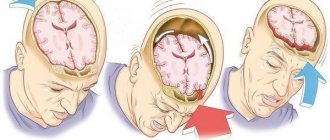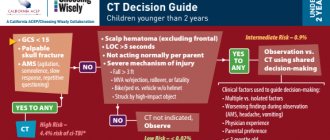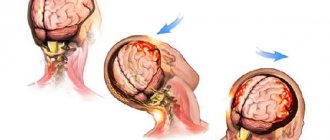Head injuries are a common occurrence, accompanied by diagnoses such as closed or open traumatic brain injury, in which one of the most severe forms is brain damage.
Traumatic brain injuries are classified into:
- brain concussion;
- brain contusion of varying severity;
- diffuse axonal injury to the brain (axonal rupture is a common injury during rapid changes in the direction of head movements in opposite directions, for example, back and forth in road accidents and fights);
- compression of the brain, in which an intracranial hematoma and a depressed fracture are separated;
- intracranial hemorrhage of various types.
There are symptoms that will immediately allow medical professionals to identify or suspect the presence of a traumatic brain injury. The most common:
- impaired consciousness or unconsciousness;
- Strong headache;
- photophobia;
- violation of the integrity of certain areas of the brain;
- nausea and vomiting;
- functional disorders of the cranial nerves (vision, hearing, smell, etc.).
Doctors and paramedics working in, based on their extensive experience in working with severe bodily injuries, can accurately determine the presence and severity of a traumatic brain injury.
In mild forms of head injuries, the victim remains conscious.
What to do with the victim before the ambulance arrives?
Often those around them, who want to somehow alleviate the plight of a victim with a traumatic brain injury, make mistakes that only aggravate the person’s condition, or even lead to death.
If the victim has head problems or if you are sure that the person hit his head, but there are no visible injuries, you need to follow simple rules that will help the victim wait for the ambulance to arrive.
- First of all, you should not move the victim to another place if the person is unconscious.
- To prevent the victim from choking while unconscious, it is necessary to turn the person’s head to the side.
- If a person lies in an open space on the ground, concrete, etc. in the cold season, try to cover him, prevent rain and snow from falling on the victim, so as not to complicate the condition with a possible inflammatory process that began as a result of hypothermia.
Adhering to these simple recommendations, relatives, acquaintances or random sympathizers present next to the victim help victims with traumatic brain injuries to survive and wait for professional doctors.
Before the ambulance arrives, you should not move the victim to another place.
Rehabilitation after traumatic brain injury at the Aximed clinic
The Aximed Neurology Clinic provides specialized support for patients with consequences of TBI. Time plays a huge role in the effectiveness of rehabilitation: no later than 1 month after injury (depending on the degree of damage). The next 1.5-2 years also give good results, and then the effectiveness of restoration measures decreases significantly or stops altogether. The most suitable conditions for recovery are a neurological rehabilitation center (inpatient stay or outpatient visit). A group of doctors works with a trauma victim: a neurologist, a rehabilitation specialist, a physiotherapist, a speech therapist, a psychologist and other specialists. The Aximed rehabilitation center is equipped with modern simulators to restore a sense of body balance and coordination of movements.
Lokomat therapy is effectively used after a traumatic brain injury, which allows the body to regain lost functions. The essence of the therapy is that regular repetition of certain natural (but lost) movements promotes the formation of new nerve connections that “remember” and reproduce this movement instead of the destroyed connections. For example, the latest robotic device ArmeoSpring, which helps restore hand function even with minimal preserved nervous reactions.
Neurologists at the Aximed Clinic strongly advise you to protect your head from injuries and take precautions (wear helmets when riding bicycles or motorcycles, helmets when doing construction work, avoid places of increased risk of injury), and in case of injury, which is accompanied by dizziness, vomiting and confusion, urgently contact emergency room or to a neurologist. Timely treatment and rehabilitation measures can completely restore the body’s previous functions and maintain a high quality of life.
Diagnosis and treatment of TBI
In addition to external signs, traumatic brain injuries are diagnosed using special neurological tests, electroencephalography and tomography (MRI or CT).
Treatment of TBI is divided into two stages:
- acute: relief of symptoms accompanying the injury itself (surgery may be required);
- rehabilitation: includes medication-assisted recovery after injury and rehabilitation of lost functions due to severe brain damage.
Alas, most mild TBIs remain undiagnosed, since people usually believe that a slight blow to the head has no consequences, and periodic headaches, memory loss and other neurological disorders are in no way associated with such microtraumas. However, common consequences of TBI include:
- impaired coordination of movements, gait, dysfunction of the upper limbs,
- sleep disturbances, fatigue,
- causeless anxiety, apathy, irritability,
- disturbances of attention and memory, decreased mental abilities,
- disturbances in the functioning of the sense organs (vision, hearing, tactile sensitivity),
- medical complications: acquired epilepsy, edema or dropsy of the brain, etc.
If you have had cases of head injury and periodically notice the signs of TBI listed above, you should visit a consultation with a neurologist. Even minor injuries can eventually manifest into unpleasant complications that reduce a person’s quality of life.
Traumatic brain injury
Traumatic brain injury (abbreviated as TBI ) is mechanical damage to the skull and intracranial structures: the brain, blood vessels, cranial nerves, meninges. Brain damage due to trauma can be primary, directly related to the mechanical impact at the time of injury, and secondary, caused by complications of TBI. Severe traumatic brain injury is accompanied by the occurrence of intracranial hematomas and brain contusions. Due to these reasons, severe TBI can lead to cerebral edema, coma and require immediate resuscitation and surgery!
There are different classifications of traumatic brain injury and its severity.
Closed traumatic brain injury (the skin and underlying tissues of the head retain their integrity) includes:
- Brain concussion. The most favorable option, as a rule, occurs without serious consequences;
- Brain contusion. A more complex version of brain damage than just a concussion is fraught, depending on the degree, location and volume, with death or severe disability, and may require long-term intensive care treatment and neurosurgical operations;
- Intracranial hematoma. This is a very serious form of TBI - compression of the brain by a hematoma: epidural, when blood fills the area between the bone and the outer (dura) mater, subdural (blood accumulation occurs under the dura mater). There are also intracerebral and intraventricular hematomas in the thickness of the medulla. Depending on the volume, location and displacement caused by the hematoma, these hematomas often require immediate surgery and long-term intensive care. If these conditions are not met, death or permanent disability is most likely.
- Diffuse axonal injury (acceleration-deceleration injury) - when it breaks the connections between the processes of nerve cells in the brain. Long-term intensive care is required. Death or severe disability is very likely.
Open traumatic brain injury (has signs of disruption of the integrity of the soft tissues of the head, skull bones and dura mater) includes:
- Fracture of the vault and base of the skull with damage to soft tissues;
- Fracture of the base of the skull with damage to local blood vessels, which entails blood flowing out of the nostrils or from the auricle after the moment of impact.
Let's consider some complaints and signs of TBI in various types of traumatic brain injuries:
When a concussion occurs, the following symptoms are observed:
- Having hit his head (or received a blow from the outside), the patient may immediately, but briefly, lose consciousness;
- Often, after loss of consciousness, lethargy sets in, but psychomotor agitation can also be observed;
- Headache, nausea and vomiting (not repeated) after injury, dizziness, and insomnia may also appear;
- Sometimes there is pallor of the skin, cardiac arrhythmia (tachy- or bradycardia);
- Often there is a memory impairment such as retrograde amnesia - a person is unable to remember the circumstances that preceded the injury.
In case of TBI, what is evidenced by drops or a stream of blood flowing from the ear and (or) nose and bruises around the eyes like glasses? This may be signs of fractures of the base of the skull and facial bones, which requires immediate examination by a traumatologist or neurosurgeon.
In severe TBI in the form of brain contusion and intracranial hematomas, the following groups of symptoms appear:
- local lesions (changes in the width of one or both pupils and paralysis of the limbs).
- general cerebral disorders (repeated vomiting, severe headache, prolonged impairment of consciousness, up to varying degrees of coma)
In case of coma, it is necessary to provide first aid (turn the person on his stomach or side, remove mucus and stomach contents from the mouth) and immediately call a doctor or emergency medical care for hospitalization in the hospital intensive care unit.
Hospital, coma, severe head injury, intensive care - these are frightening words for any person, especially if an accident happened to someone you love. But at this moment, not only a person’s health, but also a person’s life depends on your actions. Therefore, do not hesitate and do not allow panic to take over you. Call an Ambulance for hospitalization at the nearest hospital, and then contact a resuscitation consultant at “Special Medical Care” for transfer to a specialized medical center. Treatment and rehabilitation of a patient after a coma should be carried out under the supervision of a qualified specialist. Why is it necessary to transfer a patient with severe TBI to a specialized medical center? Yes, because in small regional hospitals there is not enough diagnostic and treatment equipment and qualified specialists to work with it.
Primary diagnosis in small regional hospitals in the case of traumatic brain injuries, vascular diseases and brain tumors is carried out in the following order:
- A thorough neurological examination, including a detailed ophthalmological examination of visual acuity and fields, as well as the fundus.
- X-ray (in 2 projections) can reveal damage to the skull bones, secondary signs of intracranial hypertension and sometimes local changes in the bones of the skull.
- Echoencephaloscopy is used to establish a preliminary diagnosis if an intracranial hematoma or brain contusion is suspected.
- Lumbar puncture. It is used to measure pressure and laboratory analysis of cerebrospinal fluid, but is currently practically not used for diagnostic purposes in neuro-oncology. It should be remembered that in case of injuries, vascular diseases of the brain and increased intracranial pressure, lumbar puncture can cause dislocation and herniation of the brain and therefore, without CT (computed tomography), MRI (magnetic resonance imaging) and without special indications, it is better not to do it .
To diagnose brain damage, Computed Tomography or Magnetic Resonance Imaging is essential . Remember that the lack of timely diagnosis and treatment for TBI can lead to disability or even death for the patient. An emergency consultation is required with a neurosurgeon for possible emergency surgery and a neuroresuscitator for conservative therapy and determining the patient’s transportability. A qualified specialist will be able to determine whether the patient has suffered a severe brain injury or an intracranial hematoma.
Remember that the lack of timely diagnosis and specialized treatment in peripheral hospitals can lead to future disability or death!
Treatment of TBI depends on the possibility of diagnosis and the availability of specialists, as well as the type, degree, location of brain damage and the condition of the patient himself. In some cases, a neurosurgical operation may be vitally necessary, which must be performed by a qualified specialist: a neurosurgeon. As an exception, in the absence of a neurosurgeon, this operation can be performed by a traumatologist or general surgeon.
It is hospitalization in specialized medical centers that makes it possible to correctly diagnose, stabilize and improve the condition of a patient with a head injury in a coma, and to avoid or overcome the complications of a coma. All this reduces the mortality and disability of victims of TBI.
The main condition for a favorable prognosis in a comatose state due to TBI is the ability of the patient to be in these specialized medical centers without deterioration and on time. This is precisely where interaction between the patient’s relatives and our company’s doctors is necessary. We can help at any stage: advice by phone (listed at the beginning of the site), consultation in the department where the patient is in a coma, as well as organize transportation and hospitalization to specialized medical centers in Moscow.
Call us and we can help your injured relatives with a head injury!
The “Special Medical Assistance” consulting service is ready to help you and give professional advice, to choose a medical institution where treatment and rehabilitation after TBI will be most competently prescribed. Our specialist consultants have extensive medical practice, which allows them to fully analyze the diagnosis and condition of the patient and select an institution that specializes in your particular case - for example, traumatic brain injury. Rehabilitation, treatment and examination in the clinic we have chosen will definitely be at their best! In addition, we offer reliable and safe transportation of the patient and hospitalization to the selected center.








